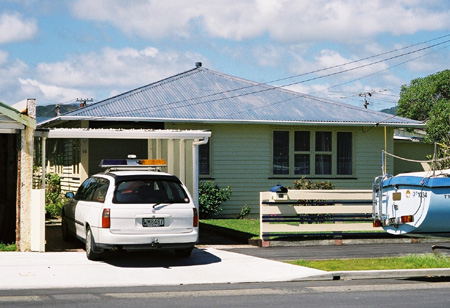This house is one of the first state houses built in New Zealand. Under the Workers' Dwelling Act 1905 the Liberal Government, led by Premier Richard John Seddon, undertook to provide low cost but quality housing to working families. Land was purchased in the suburbs of the four main centres (Auckland, Wellington, Christchurch, and Dunedin). In order to avoid an image of a 'workers barracks' by erecting all houses to the same design, a competition was held to find a number of designs. From the winning entries two sets of designs were produced, one for the North Island and one for the South Island, to take account of the climatic variation between the two islands. Petone was chosen as the site for the first of these houses primarily because Wellington was considered to have the highest rents in the country. In 1906 the first 25 houses, based on seven designs by prominent New Zealand architects, were built in what was named the Heretaunga Settlement. Initially, interest in applying for the houses was small, primarily due to the cost of rent and the distance of the settlement from the main industrial areas of Petone and Wellington City. Many workers also found it difficult to find the deposit needed to apply for the house. Although changes were made to increase the maximum income limit a worker was allowed to earn, it was not until transport improved that the houses became fully tenanted. Only 9 more houses were built in Petone under the 1905 Act, and by 1919 only 657 had been built throughout the whole country. In 1984 the registered properties in Patrick Street and adjoining Adelaide Street constructed under the Workers' Dwellings Act 1905 were declared part of an Historic Area by the New Zealand Historic Places Trust. This house style, known as Design No.3, was the result of a brief partnership between the two Christchurch-based architects Samuel Hurst Seager (1854-1933) and Cecil Walter Wood (1878-1947). It was built by Page and Anderson. It is considered to be the most innovative of the houses built under the Workers' Dwelling Act. With its low-pitched pyramid-shaped roof, Design No.3 is reminiscent of the Californian Bungalow-styled house, and in many ways the exterior of the building anticipates the state houses erected by the first Labour Government (1935-1949). Inside, the rooms feature dark stained rimu panelling. A back verandah was once the location of the earth closet and fuel-box on one side, and the food safe on the other. The smell from the earth closet was so great that it was eventually moved to the rear of the section. This house has great historical significance as it was one of the first state houses built under the Workers' Dwelling Act 1905, the first large-scale central government initiative to provide affordable housing to low-income working families. It was part of a wider package of social legislation passed by the Liberal Government (1893-1912). It is also significant as it was designed by notable architects, Samuel Hurst Seager and Cecil Wood.

Location
List Entry Information
Overview
Detailed List Entry
Status
Listed
List Entry Status
Historic Place Category 2
Access
Private/No Public Access
List Number
3587
Date Entered
6th June 1984
Date of Effect
6th June 1984
City/District Council
Hutt City
Region
Wellington Region
Legal description
Sec 8 Blk VIII Heretaunga Settlement (RT WN461/213), Wellington Land District
Related listings
Stay up to date with Heritage this month
